小学英语介词讲解与练习
小学英语英语介词及答案含答案

小学英语英语介词及答案含答案一、选择题Xinjiang cotton is praised the best cotton in the country its high quality.A. for; asB. for; byC. as; forD. by; forMy family get together and have a big dinner Sundays.A.atB. inC. onD.toThe 20th China JiangningHengxi Watermelon Festival was held May this year.A.atB. onC. inD.fromIn western countries, children play “trick or treat"the evening of October 31st.A.atB. inC. onD.toThe underground in this city has been service for almost 3 years.A.onB. inC. atD.of一You look frightened, what9 s up?一 A terrible accident happened this morning. A truck was running fast when an old man was about to cross the road. I bet he will not live the night.A. alongB. awayC. throughD. insmall actions ,like reusing water, we can make a great difference to our world.A. AcrossB. BeyondC. ThroughD. AgainstA study shows that rude languages spoken to children may have bad results that go those of beating them.A. againstB. beyondC. exceptD. withVolunteering is a good way to experience life the campus 校园).Take an activepart in it, and you will learn more about the world.A. overB. beyondC. againstD. aboveOn sunny days, my grandma often reads a novel the window.A. forB. byC. withD. fromAlmost everyone was touched words after they saw Jia Ling's moving film HiMom.A. beyondB. underC. ofD. inA new bridge the Yangtze River in Nanjing opened to traffic on Dec. 24,2020.A. throughB. overC. onD. along一Maybe you should call her up.——But I don't want to talk with her the phone.A. atB. inC. onD. withThe blue planet is so far from the earth that radio signals, travel the speed of light,take 16 hours to reach the spacecraft.A. forB. inC. onD. at一I can't think of any other actress who is more beautiful than Audrey Hepburn.一You've got the point. Her beauty is words and she succeeded hard work.A. over; byB. over; through句意:让我高兴的是,我的家人总是支持我,所以我有极大的勇气去追寻我的梦想。
小学四年级英语介词练习

小学四年级英语介词练习介词的概念介词是连接名词、代词或动词与其他词语的一种成分。
它可以用来表示时间、地点、方向、原因、目的等多种关系。
常见的介词以下是一些常见的介词及其用法:1.in:表示在某个时间、地点、状态或具体范围内。
如:in the morning(在早上)、in the park(在公园)、in trouble(陷入麻烦)。
2.on:表示在某个具体的表面或时间上。
如:on the table(在桌子上)、___(在星期一)。
3.at:表示在某个具体的时间、地点或位置上。
如:at 8 o'clock (在8点钟)、___(在学校)、___(在街角)。
4.to:表示向某个地方或目标。
如:go to school(去学校)、give it to me(给我)。
5.with:表示带有某种特征、伴随或附加动作。
如:play with friends(和朋友一起玩)、write with a pen(用钢笔写)。
6.by:表示运输方式、手段或经由某个途径。
如:go by bus (坐公交车去)、send it by email(通过电子邮件发送)。
练题请仔细阅读以下句子,选择合适的介词填入括号中。
1.We usually have lunch __________ 12 o'clock.(in。
on。
at)2.The cat is sleeping __________ the sofa.(on。
in。
at)3.He lives __________ a big house.(in。
on。
at)4.I'm going __________ the park.(in。
on。
to)5.She always goes shopping __________ her mother.(with。
by。
to)参考答案1.at2.on3.in4.to5.with希望以上练习能够帮助你更好地掌握英语介词的使用。
小学常用介词讲解及练习

小学英语总复习小学英语介词总结介词(Preposition )一、概述介词是英语中很活跃的词,一般置于名词之前。
它常和名词或名词性词语构成介词短语。
同一个介词常和不同的词语搭配形成固定搭配,表示不同意义。
1、小学英语介词at,in与on表示时间时的用法in; on; at用在时间词前,表"在”at表示时间的一点;in表示一个时期;on表示特殊日子。
如:He goes to school at seven o ' clock in the mornin他早晨七点上学。
Can you fin ish the work in two days. 你能在两天内完成这个工作吗?Linda was born on the sec ond of May. 琳达五月二日出生。
1). at + 具体时刻,I go to school at 8 o'lock.At后常接几点几分,天明,中午,日出,日落,开始等。
如:at five o ' clo(五点),at dow n (黎明),at daybreak (天亮),at sun rise (日出),at noon (中午),at sun set (日落),at midni ght (半夜),at the beg inning of the month(月初),at that time (那时),at that mome nt (那会儿),at this time of day (在一天的这个时候)。
2). in +年、月、季节及一天中的上午、下午、晚上。
in 2006 (2006 年),in May , 2004 (2004 年五月),in the morning (早晨/上午),inthe after noon (下午),in the evening (晚上),in the ni ght (夜晚),in the daytime(白天),in the 21st century (21 世纪),in three days (weeks/month )三天(周/个月),in a week (一周),in spri ng (春季)。
广州小学英语五年级介词in-on-at及其练习附答案
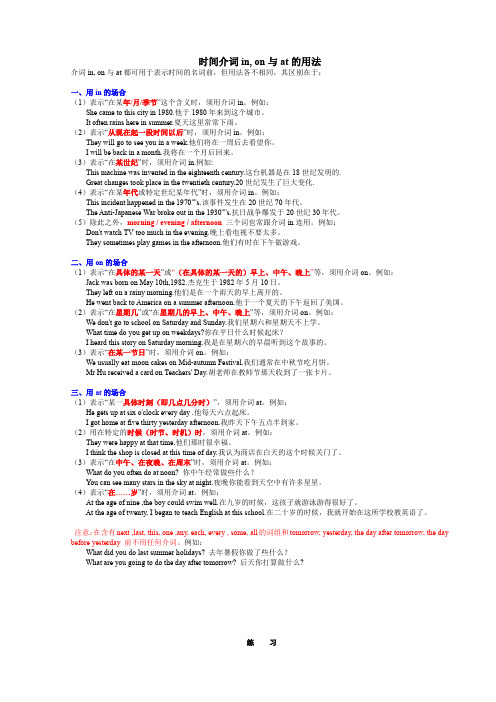
时间介词in, on与at的用法介词in, on与at都可用于表示时间的名词前,但用法各不相同,其区别在于:一、用in的场合(1)表示“在某年/月/季节”这个含义时,须用介词in。
例如:She came to this city in 1980.他于1980年来到这个城市。
It often rains here in summer.夏天这里常常下雨。
(2)表示“从现在起一段时间以后”时,须用介词in。
例如:They will go to see you in a week.他们将在一周后去看望你。
I will be back in a month.我将在一个月后回来。
(3)表示“在某世纪”时,须用介词in.例如:This machine was invented in the eighteenth century.这台机器是在18世纪发明的.Great changes took place in the twentieth century.20世纪发生了巨大变化.(4)表示“在某年代或特定世纪某年代”时,须用介词in。
例如:This incident happened in the 1970''''s.该事件发生在20世纪70年代。
The Anti-Japanese War broke out in the 1930''''s.抗日战争爆发于20世纪30年代。
(5)除此之外,morning / evening / afternoon三个词也常跟介词in连用。
例如:Don't watch TV too much in the evening.晚上看电视不要太多。
They sometimes play games in the afternoon.他们有时在下午做游戏。
二、用on的场合(1)表示“在具体的某一天”或“(在具体的某一天的)早上、中午、晚上”等,须用介词on。
小学英语《常见介词及其应用》练习
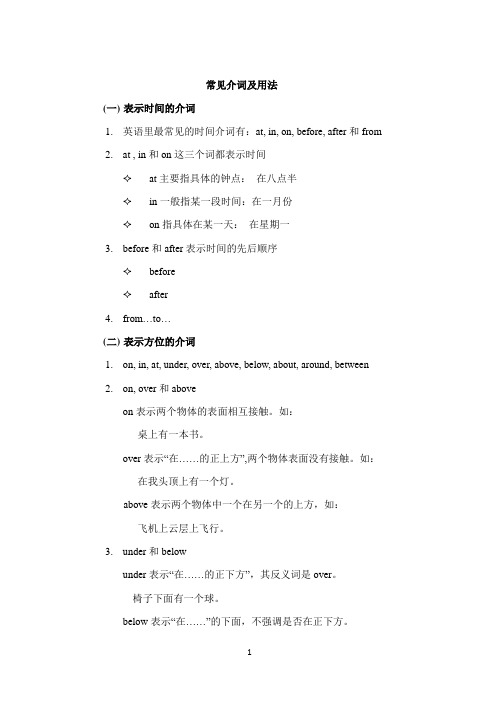
常见介词及用法(一)表示时间的介词1.英语里最常见的时间介词有:at, in, on, before, after和from2.at , in和on这三个词都表示时间✧at主要指具体的钟点:在八点半✧in一般指某一段时间:在一月份✧on指具体在某一天:在星期一3.before和after表示时间的先后顺序✧before✧after4.from…to…(二)表示方位的介词1.on, in, at, under, over, above, below, about, around, between2.on, over和aboveon表示两个物体的表面相互接触。
如:桌上有一本书。
over表示“在……的正上方”,两个物体表面没有接触。
如:在我头顶上有一个灯。
above表示两个物体中一个在另一个的上方,如:飞机上云层上飞行。
3.under和belowunder表示“在……的正下方”,其反义词是over。
椅子下面有一个球。
below表示“在……”的下面,不强调是否在正下方。
他们家的房子在我家的下面。
4.in表示位置“在……里面”,也可以用来表示在一个很大的空间内。
孩子们正在房间里玩。
书都在我的书包里。
5.at表示“在……旁边”。
老师正在桌边。
6.around表示“在……周围”。
There are lots of flowers around the house. 房子周围有许多花。
7.behind表示“在……的后面”。
别躲在树后。
8.in front of表示“在……的前面”。
9.between表示“在两者之间”。
(三)表示动向的介词。
1.常见的动向介词有:into, out of, up, down, from, to, through, along等。
2.into和out ofinto,out of简跳进了水里。
3.up和down:他经常爬山。
(四)表示方式的介词常见的表示方式的介词有:by, with, in等。
小学on in at练习题

小学on in at练习题小学on in at练习题小学生在学习英语时,常常会遇到on, in, at这些介词的使用。
这些介词在英语中非常常见,但对于初学者来说,往往会感到困惑。
在这篇文章中,我们将通过一些练习题来帮助小学生更好地理解和掌握on, in, at的用法。
练习题一:选择正确的介词填空。
1. We have a party ______ Friday.2. The cat is ______ the box.3. My birthday is ________ July.4. The book is _______ the table.5. I will meet you ______ the park.6. The pencil is _______ the desk.7. The movie starts _______ 8 o'clock.8. The dog is _______ the garden.练习题二:根据句子的意思,选择正确的介词填空。
1. I will see you _______ the weekend.2. The book is _______ the shelf.3. The bus arrives _______ 9:00 in the morning.4. The party is _______ Saturday night.5. The cat is _______ the tree.6. We will have a picnic _______ the park.7. The teacher is _______ the classroom.8. The movie starts _______ 7:30.练习题三:写出下列句子中on, in, at的正确形式。
1. My birthday is ________ November 5th.2. The book is _______ the shelf.3. The cat is _______ the roof.4. We will meet _______ the park.5. The movie starts _______ 7 o'clock.6. The party is _______ Saturday.7. The dog is _______ the garden.8. I will see you _______ the weekend.练习题四:写出下列句子中on, in, at的正确形式。
小学英语语法介词to和of与for的用法及练习含答案

小学英语语法介词to,of与for的用法To、of与for是三个极易混用的介词,在具体使用时应从以下三个方面来掌握:一、表示“……的”含义时,应根据不同的关系选用不同的介词。
1.若表示“所有,所属”关系时,用介词of。
如: the life ofthe people 人民的生活the roofof the house 屋顶2.若表示“解释,说明”关系时,用介词for。
如: the money for the shoes 鞋钱the shop for clothes 成衣店3.若表示“解答,用途”关系时,用介词to。
如:the key to the exercise 练习的答案the way to the hospital(到)医院的路二、在含有双宾语的句子中,当间接宾语(指人的宾语)置于直接宾语(指物的宾语)之后时,间接宾语之前须加上介词to或for。
1.当及物动词是give,pass,tell,teach,ask,show 等必须有双宾语意义才完整的句子中,若将间接宾语放在直接宾语之后,用介词to 连接。
如:Miss Cao teaches English to us. 曹老师教我们英语。
Please pass a cup oftea to me.请给我一杯茶。
2.当及物动词是make,buy,fetch,get,play,find 等只需一个宾语就能表达一个完整意义的句子中,若将间接宾语放在直接宾语后面时,用介词for 连接。
如:Her uncle bought a new bike for her.她叔叔给她买了一辆新自行车。
Mother cooks breakfast for us every day.妈妈每天为我们做早饭三、当不定式短语作主语,谓语是系表结构(即“It+be+形容词+不定式”句型)时,若不定式动词需要逻辑主语时,其引导词可以是of也可以是for。
二者的选择主要取决于该句型中的形容词。
(小升初)英语语法课件-时间介词地点介词方位介词全梳理+同步练习+通用版
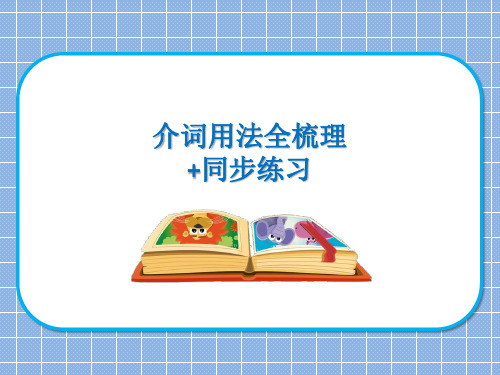
目录
1. 介词定义 2. 时间介词at, on, in 3. 地点介词at, in 4. 方位介词on, above, over 5. 易错点总结 6. 小试牛刀
1. 介词定义
介词是一种虚词。需要和名词、代词等构成 介词短语,才能担当句子成分。
2. 时间介词
1. at+具体时间/时刻
Sam gets up at six ___ the morning and goes to bed ___ nine.
牛刀小试
Sam gets up at six in the morning and goes to bed at nine.
牛刀小试
Mom will be well again ___ three weeks’ time.
牛刀小试
Mom will be well again in three weeks’ t ___ Christmas and ___ his birthday.
牛刀小试
Tom gets gift at Christmas and on his birthday.
e.g: He gets up at 7:10.
e.g: The plane took off at 19:30. 固定搭配:at noon, at night, at Christmas
(在圣诞节期间)
2. on+星期几/具体日期/具体某天 e.g: We will have a picnic on Monday. e.g: Christmas is on December 25th.
注意啦~ on Christmas Day 在圣诞节当天
3. 地点介词
小学英语方位介词(含练习题)
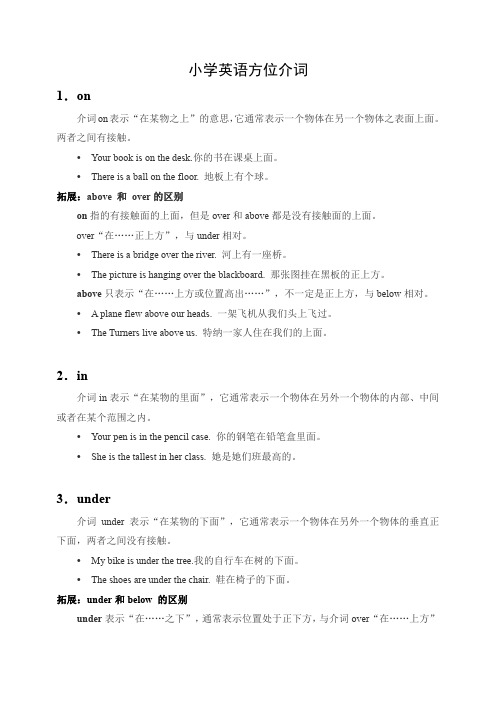
小学英语方位介词1.on介词on表示“在某物之上”的意思,它通常表示一个物体在另一个物体之表面上面。
两者之间有接触。
•Your book is on the desk.你的书在课桌上面。
•There is a ball on the floor. 地板上有个球。
拓展:above 和over的区别on指的有接触面的上面,但是over和above都是没有接触面的上面。
over“在……正上方”,与under相对。
•There is a bridge over the river. 河上有一座桥。
•The picture is hanging over the blackboard. 那张图挂在黑板的正上方。
above只表示“在……上方或位置高出……”,不一定是正上方,与below相对。
• A plane flew above our heads. 一架飞机从我们头上飞过。
•The Turners live above us. 特纳一家人住在我们的上面。
2.in介词in表示“在某物的里面”,它通常表示一个物体在另外一个物体的内部、中间或者在某个范围之内。
•Your pen is in the pencil case. 你的钢笔在铅笔盒里面。
•She is the tallest in her class. 她是她们班最高的。
3.under介词under表示“在某物的下面”,它通常表示一个物体在另外一个物体的垂直正下面,两者之间没有接触。
•My bike is under the tree.我的自行车在树的下面。
•The shoes are under the chair. 鞋在椅子的下面。
拓展:under和below 的区别under表示“在……之下”,通常表示位置处于正下方,与介词over“在……上方”相对应。
•There is a book under the table.桌子下面有一本书。
• A cat is sitting under the table.一只猫在桌子下面。
小学英语介词的用法及专项练习

小学英语介词的用法及专项练习介词的定义和作用介词是英语中一类重要的词性,用于连接名词、代词、动词或者其他介词与其他成分之间的关系。
介词可以表达方向、位置、原因、时间等等。
常见的英语介词有:in, on, at, for, with, by, from, to, over, under 等。
介词的用法1. 表示地点表示地点- in: 在某个区域或范围内- The cat is in the box.(猫在盒子里。
)- on: 在某个平面或表面上- The book is on the table.(书在桌子上。
)- at: 在某个具体的位置- She is waiting at the bus stop.(她在公交车站等待。
)2. 表示时间表示时间- at: 表示具体的时间点- The meeting starts at 9 o'clock.(会议在9点开始。
)- on: 表示某一天或日期- I have an appointment on Monday.(我在星期一有个约会。
)- in: 表示一段时间内- They will go on vacation in July.(他们将在七月份去度假。
)3. 表示原因表示原因- for: 表示目的或理由- We go to the park for a picnic.(我们去公园野餐。
)4. 表示方式表示方式- with: 表示伴随或使用- She writes with a pen.(她用钢笔写字。
)5. 表示运动表示运动- from...to: 表示由某个地方到另一个地方- He walked from home to the school.(他从家里走到学校。
)介词练请根据句子的意思,选择适当的介词填空。
1. The dog is __ the yard.(狗在院子里。
)2. My birthday is __ Sunday.(我的生日在星期天。
【优质讲义】小学英语语法归纳训练讲义-12 介词in,on,at 全国通用版(含答案)

语法——介词in on atPart 1:学问点一、介词:是一种虚词,在句子中表示名词或代词与其他词之间的关系,不能单独做为句子成分,常位于名词或代词前面构成介词短语。
二、具体用法:常用介词1.in(1)表示方位:在……里面例句:There are three books in my bag.我书包里有三本书。
(2)表示地点:A.表示在大地方例句:I live in Hangzhou.我住在杭州。
B.表示属于该范围例句:Hei Longji ang lies in the north of China.黑龙江在中国北部。
(3)表示时间:A.表示一段时间(比较长)例:in summer在夏天in 2021在2021年in February 在二月B.表示在早上、下午、晚上例:in the morning/afternoon/evening(4)表示使用某种材料、语言等:例句:I can sing the song in English.我能用英语唱这首歌。
2.on(1)表示地点:在……上面例句:There is an apple on the desk.桌子上有一本书。
(2)表示时间:A.表示在具体某一天的上午、下午或晚上例:on June thirteenth在六月13日on the morning of May 1st在五月一日的早上B.表示在星期几的上午、下午或晚上例:on Friday在周五on Saturday afternoon在周六的下午2.at(1)表示在小地点:例:at school /home(2)表示时间点:例:at seven在七点at night在夜晚Part 2:练习一、用介词填空。
1.My mother begins to work ______ 8:00 ______ t he morning.2.Do you stay ______ home ______ weekend?3.They live ______ a new house now.4.Xinjiang is ______ the west of China.5.Lily usually have breakfast ______ the morning.6.They often have lunch ______ half past twelve.7.What’s this ______ English?8.There is a big gym ______ my school.9.She came to this city ______ 2020.10.It often snows here ______ winter.11.I will be back ______ a month.12.Don’t watch TV too much ______ the evening.13.Sally was born ______ May 11th.14.We don’t go to school ______ Saturday and S unday.15.They were happy ______ that time.16.______ the age of ten, I began to learn English.17.What do you often do ______ noon?18.______ a cold winter morning, I met her in the street.19.Mrs. Green came to Beijing ______ 2005.20.Children wake up very early ______ the morning ofChristmas Day.答案:1.at in2.at on3.in4.in5.in6.at7.in8.in9.in 10.i n 11.in 12.in 13.on 14.on 15.at 16.At 17.at 18.On 19.in 20.on。
小学六年级英语介词知识点及练习题
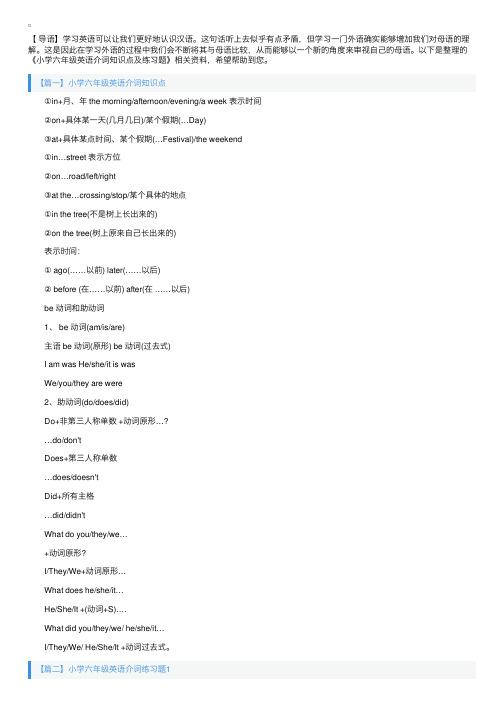
【导语】学习英语可以让我们更好地认识汉语。
这句话听上去似乎有点⽭盾,但学习⼀门外语确实能够增加我们对母语的理解。
这是因此在学习外语的过程中我们会不断将其与母语⽐较,从⽽能够以⼀个新的⾓度来审视⾃⼰的母语。
以下是整理的《⼩学六年级英语介词知识点及练习题》相关资料,希望帮助到您。
【篇⼀】⼩学六年级英语介词知识点 ①in+⽉、年 the morning/afternoon/evening/a week 表⽰时间 ②on+具体某⼀天(⼏⽉⼏⽇)/某个假期(…Day) ③at+具体某点时间、某个假期(…Festival)/the weekend ①in…street 表⽰⽅位 ②on…road/left/right ③at the…crossing/stop/某个具体的地点 ①in the tree(不是树上长出来的) ②on the tree(树上原来⾃⼰长出来的) 表⽰时间: ① ago(……以前) later(……以后) ② before (在……以前) after(在 ……以后) be 动词和助动词 1、 be 动词(am/is/are) 主语 be 动词(原形) be 动词(过去式) I am was He/she/it is was We/you/they are were 2、助动词(do/does/did) Do+⾮第三⼈称单数 +动词原形…? …do/don't Does+第三⼈称单数 …does/doesn't Did+所有主格 …did/didn't What do you/they/we… +动词原形? I/They/We+动词原形… What does he/she/it… He/She/It +(动词+S)…. What did you/they/we/ he/she/it… I/They/We/ He/She/It +动词过去式。
【篇⼆】⼩学六年级英语介词练习题1 ( ) 1. Why did you get up so early ___ this morning.A. onB. /C. atD. in ( ) 2. He went to Shanghai___ September 3, 1991 and came back___ a cold morning last year.A. in; onB. on; inC. on; onD. in; ia ( ) 3. Lucy was born____ the night of May 12, 1984.A. onB. inC. atD. to ( ) 4. Mrs Brown came to China ____ 1996.A.onB. ofC. toD. in ( ) 5 ___ the morning of November 20, 1915, the workers came to Chicago to show their mourning of Joe Hill.A. OnB. InC. OnD. At ( ) 6. Ann moved___Hangzhou___September, 1992.A. /; inB. to; inC. to; on D, in; in ( ) 7. They started off___an autumn afternoon.A. duringB. atC. inD. on ( ) 8. He often goes ____ school ____ six thirty ____ the morning.A. for; to; inB. to; at; inC. to; for; at D, for; at; to ( ) 9. He arrived ___ Shanghai ___ 9: 30 ___ March 5.A. at; in; atB. to; on; atC. in; on; atD. in; at; on ( ) 10.The English teacher told me to get there____ half past ten.A. inB. atC. onD. of 参考答案: B C A D B A D B D B【篇三】⼩学六年级英语介词练习题2 ( ) 1. Children get gifts ____ Christmas and ____ their birthdays.A. on; onB. at; onC. in; inD. in; on ( ) 2.----There is nothing ____tomorrow afternoon, is there? -----No. We can have a game of table tennis.A. onB. inC. outD. up ( ) 3. A lot of students in our school were born____March, 1981.A. inB. atC. onD. since ( ) 4. He suddenly returned____ a rainy night.A. onB. atC. inD. during ( ) 5. My grandfather was born____Oct. 10, 1935.A. onB. inC. atD. of ( ) 6. The train is starting___five minutes.A. inB. atC. forD.still ( ) 7. Mike does his exercises ____ seven _____ the evening.A. on; toB. at; inC. by; ofD. at; on ( ) 8. Children wake up very early____the morning of Christmas Day.A. inB. onC. forD. at ( ) 9 ____ a cold winter morning, I met her in the stfeet.A. InB. OnC. AtD. For ( ) 10 It happened to be very cold____ the morning of our sports meeting.A. atB. onC. withD. of 参考答案:B A A A A A B B B B。
小学英语语法——介词知识点讲解+练习
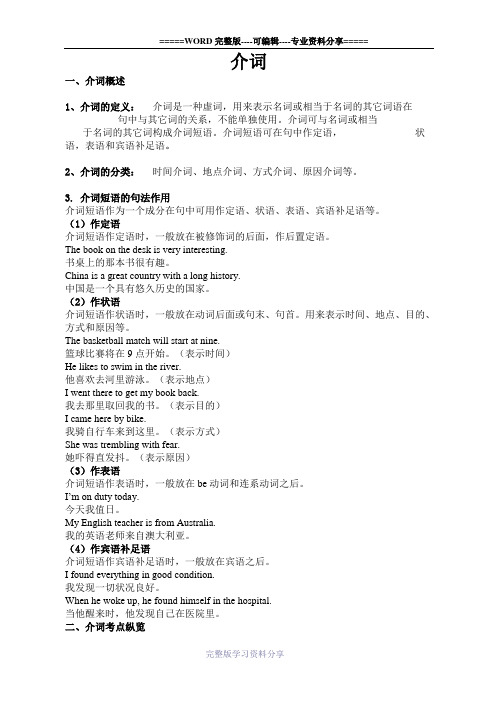
介词一、介词概述1、介词的定义:介词是一种虚词,用来表示名词或相当于名词的其它词语在句中与其它词的关系,不能单独使用。
介词可与名词或相当于名词的其它词构成介词短语。
介词短语可在句中作定语,状语,表语和宾语补足语。
2、介词的分类:时间介词、地点介词、方式介词、原因介词等。
3. 介词短语的句法作用介词短语作为一个成分在句中可用作定语、状语、表语、宾语补足语等。
(1)作定语介词短语作定语时,一般放在被修饰词的后面,作后置定语。
The book on the desk is very interesting.书桌上的那本书很有趣。
China is a great country with a long history.中国是一个具有悠久历史的国家。
(2)作状语介词短语作状语时,一般放在动词后面或句末、句首。
用来表示时间、地点、目的、方式和原因等。
The basketball match will start at nine.篮球比赛将在9点开始。
(表示时间)He likes to swim in the river.他喜欢去河里游泳。
(表示地点)I went there to get my book back.我去那里取回我的书。
(表示目的)I came here by bike.我骑自行车来到这里。
(表示方式)She was trembling with fear.她吓得直发抖。
(表示原因)(3)作表语介词短语作表语时,一般放在be动词和连系动词之后。
I’m on duty today.今天我值日。
My English teacher is from Australia.我的英语老师来自澳大利亚。
(4)作宾语补足语介词短语作宾语补足语时,一般放在宾语之后。
I found everything in good condition.我发现一切状况良好。
When he woke up, he found himself in the hospital.当他醒来时,他发现自己在医院里。
小学英语语法归纳训练讲义-13方位介词全国通用版(含答案)

语法——方位介词Part 1:知识点1.in在……里面例句:There are many apples in the basket.篮子里有许多苹果。
2.on在……上面(有接触)例句:There is a book on the desk.桌子上有一本书。
3.over在……上面(不接触)例句:There is a bridge on the river.河上有座桥。
4.under在……下面例句:There is a ball under the chair.椅子下面有一个球。
5.before在……之前例句:Micky stands before Joe.Micky站在Joe前面。
6.behind在……后面例句:There is a tree behind the house.房子后面有一棵树。
7.beside在……旁边例句:A cat is beside the TV.电视旁边有一只猫。
8.near在……附近例句:There is a zoo neat the park.公园旁边有一个动物园。
9.next to紧挨着例句:The library is next to the gym.图书馆紧挨着体育馆。
10.i n front of在……前面例句:There is a car in front of the house.房前有一辆车。
【拓展】in the front of(在内部靠前的位置)例句:The teacher is standing in the front of the classroom.教师站在教室的前面。
11.i n the middle of在……中间例句:There is a lake in the middle of the zoo.动物园中间有一个湖。
【拓展】between在两者之间,常与and连用例句:There is a bridge between the two village.在两个村子中间有一座桥。
小学英语介词讲解与练习

介词是表示两个词之间的关系的词。
介词短语指的是某一个词和另外一个词组成固定搭配,表示一个固定的意思。
(一)常见的方位介词1。
on There is a pencil on the desk2. in I have a book in the bag.3. under There is a dog under the chair.4。
over The picture is over the bed.5. by I can see a building by the river.6. in front of There is a bus in front of the house。
7. behind Mike is behind Jack。
8。
on the left I sit on the left。
9. on the right You can see the cinema on the right.10. near My house is near my school。
11。
beside The trash bin is beside the door。
12. beside\near /next to在。
旁边,在…附近beside the window, near the school。
Exercise:( )1. Is there a river ______ the house?A。
to B。
of C。
in D。
behind() 2。
They’re running _______ the playground.A. with B。
in C。
at( ) 3. Can we eat _______ Guangzhou Restaurant today?A。
to B。
of C。
at()4。
She studies English ______ Rose School ____ England.A. at,from B。
小学四年级常用介词总结与句型练习
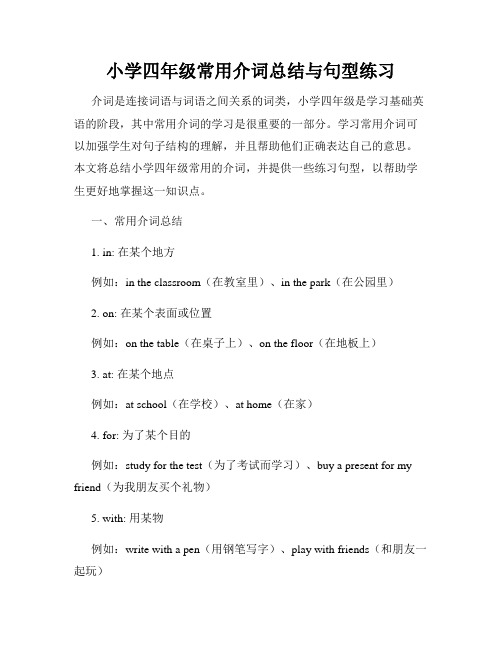
小学四年级常用介词总结与句型练习介词是连接词语与词语之间关系的词类,小学四年级是学习基础英语的阶段,其中常用介词的学习是很重要的一部分。
学习常用介词可以加强学生对句子结构的理解,并且帮助他们正确表达自己的意思。
本文将总结小学四年级常用的介词,并提供一些练习句型,以帮助学生更好地掌握这一知识点。
一、常用介词总结1. in: 在某个地方例如:in the classroom(在教室里)、in the park(在公园里)2. on: 在某个表面或位置例如:on the table(在桌子上)、on the floor(在地板上)3. at: 在某个地点例如:at school(在学校)、at home(在家)4. for: 为了某个目的例如:study for the test(为了考试而学习)、buy a present for my friend(为我朋友买个礼物)5. with: 用某物例如:write with a pen(用钢笔写字)、play with friends(和朋友一起玩)6. to: 去某个地方例如:go to school(去学校)、send a letter to my grandma(给我奶奶寄信)7. from: 来自某个地方例如:come from China(来自中国)、receive a gift from my teacher (从老师那里收到礼物)8. by: 通过某种方式或工具例如:travel by plane(乘飞机旅行)、write by hand(手写)二、句型练习1. 选择合适的介词填空:a) The book is _______ the table.b) I go to school _______ bus.c) The cat is hiding _______ the chair.d) My family is going on vacation _______ July.e) We play football _______ our friends every Saturday.2. 翻译下列句子:a) 我坐在椅子上。
- 1、下载文档前请自行甄别文档内容的完整性,平台不提供额外的编辑、内容补充、找答案等附加服务。
- 2、"仅部分预览"的文档,不可在线预览部分如存在完整性等问题,可反馈申请退款(可完整预览的文档不适用该条件!)。
- 3、如文档侵犯您的权益,请联系客服反馈,我们会尽快为您处理(人工客服工作时间:9:00-18:30)。
介词是表示两个词之间的关系的词。
介词短语指的是某一个词和另外一个词组成固定搭配,表示一个固定的意思。
(一)常见的方位介词1. on There is a pencil on the desk2. in I have a book in the bag.3. under There is a dog under the chair.4. over The picture is over the bed.5. by I can see a building by the river.6. in front of There is a bus in front of the house.7. behind Mike is behind Jack.8. on the left I sit on the left.9. on the right You can see the cinema on the right.10. near My house is near my school.11. beside The trash bin is beside the door.12. beside\near /next to在..旁边,在…附近beside the window, near the school.Exercise:( ) 1. Is there a river ______ the house?A. toB. ofC. inD. behind( ) 2. They’re running _______ the playground.A. withB. inC. at( ) 3. Can we eat _______ Guangzhou Restaurant today?A. toB. ofC. at( )4. She studies English ______ Rose School ____ England.A. at, fromB. in, inC. at, in( )5 .There are many apples ___ the tree. A bird ___ the tree is picking an apple.A. in ; onB. on ; inC. in ; at(二)常见的时间介词1) at表示具体的时间点,如at five o’clock, at nine表示一段较短的时间,如:at night, at Chritmas表示人的年龄,如:at the age of six, at the age of 121) My father usually goes to work ________ (at, in, on) 8:00.2) The party will begin ______ (at, in, on) 2:00pm.2) in常与上午,下午,晚上等词连用,如:in the morning, in the afternoon, in the evening常与月份,季节,年份连用,如:in July, in summer, in 20131) We never go shopping ______ (at, in, on) the evening.2) I get up at 7:30 _______ (at, in, on) the morning.3) on常与星期连用,如:on Monday, on Sunday表示具体的一天,如:on June 1st, on May 3rd表示在某天的上午、下午或晚上,如:on Saturday morning, on the afternoon of May 5th, on a winter evening1). Christmas is __________ (at, in, on) December 25th.2) What is the first lesson(课)________ (at, in, on) Tuesday?3) Mr. Web will go to Shanghai ______ (at, in, on) Oct. 22nd.4) He often plays football with his friends _______ (at, in, on) Sunday.5) Children don’t go to school _______(at, in, on) New Year’s Day.“在星期天的早晨”这一类应用on Sunday morning( ) 1. The girl usually practices the piano ________ Saturday morning.A. onB. inC. at( )2 .He left home ___ a cold winter evening.A. atB. onC. in4) 时间表示的排列顺序,遵循小时间到大时间的表示方法at two in the afternoon(三)其他常见的介词1. for 给This book is for you..为了We have some food for picnic.作为Thank you for your present.2. from 来自I’m from China.Tom the UK. 汤姆来自于英国。
The students learn English . 学生们从我这里学英语。
3. to 到…Let’s go to school.4. with 和…You can go with me.用…I write the letter with a pen.I went to the garden ________Tom.Liu Tao is going to visit his grandpa _______his parents.带有The boy ________________is David.那个有着一双大眼睛的是大卫。
The school_________________________ is over there.那边的那个学校有34间教室。
The boy ______________________in his hand likes reading.那个手里拿着一本书的男孩很爱读书。
5. of …的He is a student of Guangzhou School.6. into 进行He goes into the door.7. by 乘…交通工具I went to school by bus.乘公共汽车乘火车乘飞机乘船(四)常见的介词短语1. a lot of 许多……2. a pair of 一对……3. at home 在家4. from…to…从……到……5. get to…到达……When did you get to Beijing?6. listen to…听……7. look at…看……8. look for…寻找……I’m looking for my story book.9. on holiday 度假My family are going to Shanghai on holiday.10. play with…与……玩You can play with Jack.11. wait for 等待We are waiting for the bus.四、课堂练习( ) 1. It’s t ime ______ supper.A. atB. inC. onD. for( ) 2. It’s no time ______ school. It’s time ______ go back home.A. to, forB. to, toC. for, to( ) 3. Mr Brown comes ______ America.A. atB. fromC. inD. to( ) 4. What’s this _____ English?A. inB. atC. onD. under( ) 5. Sometimes I go to school _____ foot.A. byB. inC. onD. with( ) 6. Count (数)_____ one _____ ten.A. from, byB. from, toC. to, toD. at, to( ) 7.My sister is looking ____ her new shoes now.A. atB. afterC. forD. to( ) 8. It’s cold outside. Please _____ your warm clothes.A. put inB. take offC. put onD. put up( ) 9. The classroom is quite different _____ that one.A. ofB. fromC. withD. like( ) 10. A: Do many children in our class often skate ________ winter?B: Yes, they usually have fun _______ winter.A. in, inB. on, onC. at, at( ) 11. A: Does the autumn start _________ August?B; Sometimes it does. But usually it starts _______ September.A. in, inB. on, onC. at, at( ) 12. I usually play table tennis ________ school.A. afterB. whenC. by( )13. I like summer. Is it cool ______ autumn? What _______ summer? Oh, it is too hot.A. in, about onB. on, about onC. in, about in( ) 14. A: Do you listen to the radio _______ a long time?B: No, I often listen to it ______________ twenty minutes.A. for, toB. for, forC. to, for( ) 15. When is May Day? It’s _______ the first of May.A. onB. inC. at( ) 16. They will move to the new school ______ next Monday.A. onB. inC. /( ) 17. He always goes to school at 7:00 ______ every day.A. onB. inC. /( ) 18. She does her homework ______ half an hour every day.A. inB. forC. /五课后作业用所给的介词填空。
